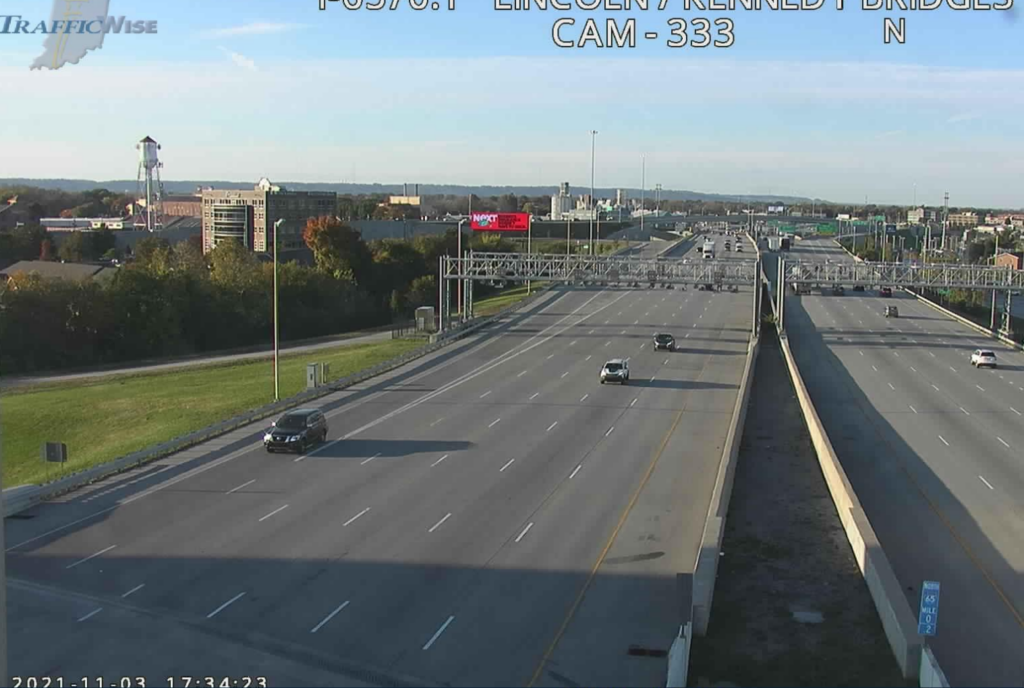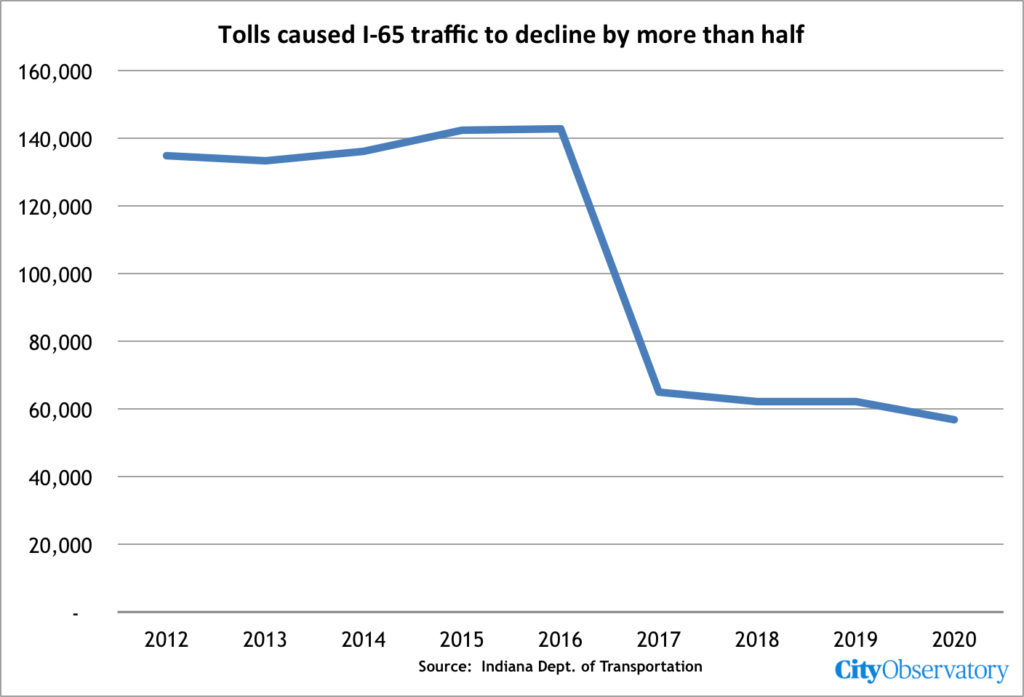Louisville charges a cheap $1 to $2 toll for people driving across the Ohio River on I-65.
After doubling the size of the I-65 bridges from six lanes to 12, tolls slashed traffic by half, from about 130,000 cars per day to fewer than 65,000.
Kentucky and Indiana wasted a billion dollars on highway capacity that people don’t use or value.
If asked to pay for even a fraction of the cost of providing a road, half of all road users say, “No thanks, I’ll go somewhere else” or not take the trip at all.
The fact that highway engineers aren’t celebrating and copying tolling as a proven means to reduce congestion shows they actually don’t give a damn about congestion, but simply want more money to build things.
Picture this. A major interstate freeway that connects the downtown of one of the nation’s 50 largest metro areas to its largest suburbs. It’s a little after 5 pm on a typical weekday. And on this 12-lane freeway there are roughly two dozen cars sprinkled across acres of concrete.
 I-65 in Southern Indiana (Trimarc)
I-65 in Southern Indiana (Trimarc)
These pictures were taken by traffic cameras pointed in opposite directions on the I-65 bridges across the Ohio River at Louisville Kentucky on Wednesday, November 3 at about 5:30 pm. Traffic engineers have a term for this amount of traffic: They call it “Level of Service A”—meaning that there’s so little traffic on a roadway that drivers can go pretty much as fast as they want. Highway engineers grade traffic on a scale from LOS A (free flowing almost empty) to LOS F (bumper to bumper stop and go). Most of the time, they’re happy to have roads manage LOS “D”.
Somebody finally figured out how to reduce traffic congestion! Usually, as we know, simply widening highways, to as many as 23 lanes as is the case with Houston’s Katy Freeway, simply generates more traffic and even longer delays and travel times. And, with no sense of irony, highway boosters even tout the Katy Freeway as a “success story,” despite the fact it made traffic congestion worse. In contrast, Louisville’s I-65 is an extraordinarily rare case where traffic congestion went away after a state highway department did something.
You’d think that the Kentucky Transportation Cabinet and the Indiana Department of Transportation would be getting a special award, and holding seminars at AASHTO to explain how to eliminate traffic congestion. The fact that they aren’t tells you all you need to know about the real priorities of state highway departments–they really only care about building things, not about whether congestion goes away or not.
So how did they do it? Let’s go back a few years. In 2010, I-65 consisted of a single six-lane bridge over the Ohio River, which carried about 120,000 vehicles per day. The two states decided this was getting too crowded (and predicted worsening delay due to ever expanding traffic volumes) and so spent about $1 billion building a second six lane bridge (the Lincoln) next to the existing Kennedy bridge. After in opened in 2017, the two states implemented a toll to pay part of the cost of construction. Tolls started at $2 for single crossings (if you had a transponder), but regular commuters were given a discounted toll: regular commuters pay just a bit over $1 for each crossing. Today the toll for one-way crossings if you have a transponder (and 450,000 area vehicles do), is $2.21. But if you cross the bridge 40 times a month (back and forth daily for 20 work days), your toll for each trip is reduced by half to $1.10.
And after the tolls went into effect, traffic on I-65 fell by half. Here’s the average daily traffic count on I-65, according to data tabulated by the Indiana Department of Transportation. In the years just prior to the tolling, traffic was in the 135,000 to 140,000 vehicles per day level. But as soon as tolling went into effect, traffic dropped to barely 60,000 vehicles per day (with a very slight further decline due to Covid-19 in 2020).
The two states spent a billion dollars doubling the size of I-65, only to have half as many people use the bridge. That money was wasted. Nothing more clearly illustrates the utter folly of highway expansions. As we’ve pointed out, highway engineers size roadways based on the assumption that the users will pay nothing for each trip. Just as with Ben and Jerry’s “Free Ice Cream Day,” when you charge a zero price for your product, people will line up around the block. But ask people to pay, and you’ll get fewer takers.
The fact that Louisville residents would rather drive miles out of their way or sit in traffic for an extra 10 or 15 minutes to travel on a “free” road, rather than spend a dollar or two for a faster, more direct trip tells you the very low value that highway users attach to these extremely expensive roadways. In fact, they’ll only drive on them if somebody else pays for the cost the roadway. This is also powerful evidence of what economists call induced demand: people only taking trips because the roadway exists and someone else is paying for it.
The Louisville traffic experiment shows us that there’s one surefire fix for traffic congestion: road pricing. Even a very modest toll (one that asks road users to pay only a third or so, at most of the costs of the roads they’re using) will cause traffic congestion to disappear. This traffic experiment shows the folly and waste of building additional capacity. Kentucky and Indiana spent over $1 billion for a bridge to carry as many as 250,000 vehicles per day, and today barely a quarter of that number are using it.
If state DOTs really cared about congestion, they’d be implementing congestion pricing. A small toll, probably less than a dollar per crossing, would be sufficient to get regular free-flow conditions on the I-65 bridge—without having to spend a billion dollars. But the truth is, state DOTs don’t care about congestion, except as a talking point to get money to build giant projects. The next time you hear someone lamenting traffic congestion, ask them why they aren’t trying the one method that’s been shown to work.


